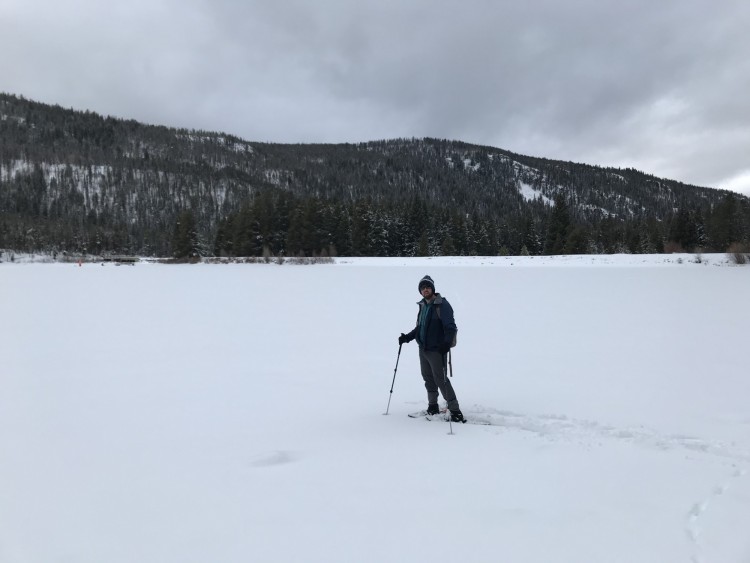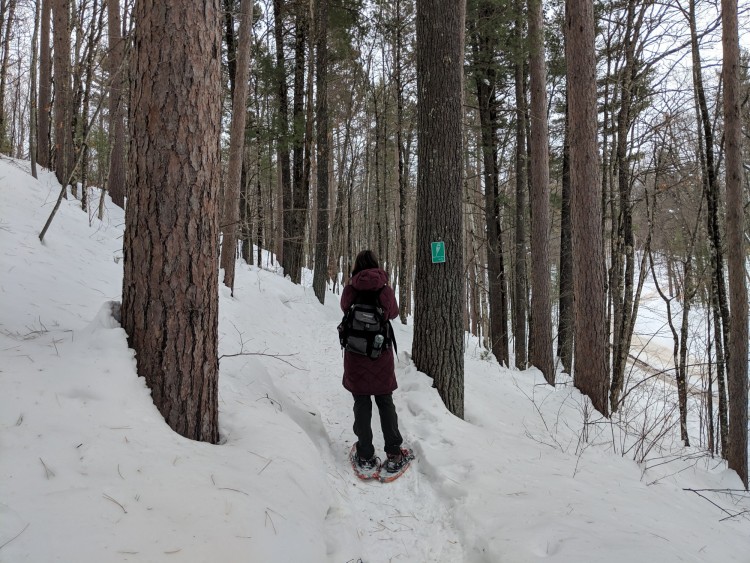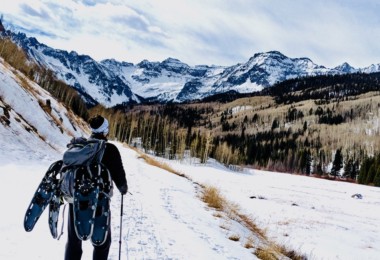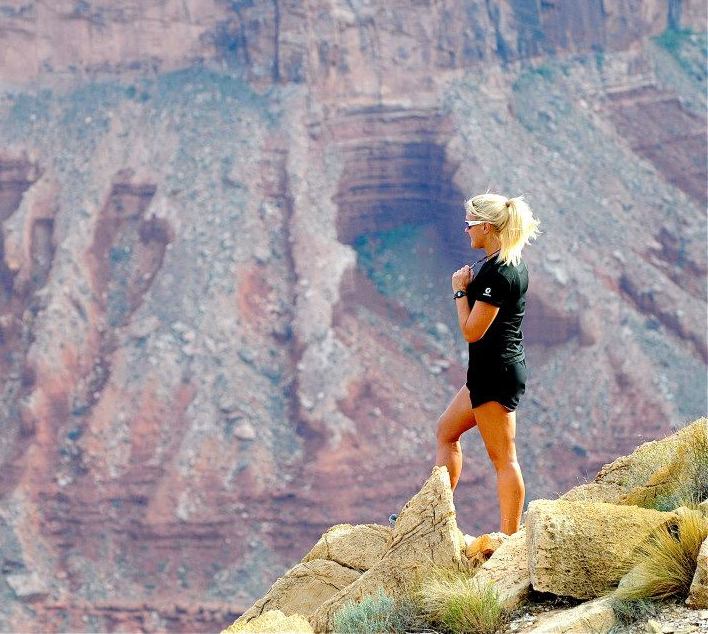The temperatures are dropping, and it’s time to enjoy a little quality time in the great outdoors. In fact, at the end of a year, unlike any other, you may be more than ready for those snowshoe getaways. Before you embark on your next outdoor adventure, though, whether it’s snowshoeing, skiing, or simply going for a winter walk, take a few moments to prepare and protect your skin.
Here are some simple winter skin care tips to keep your skin healthy all winter long.

Take care of your skin on the trail so you can be this excited for your snowshoe adventures. Photo: Susan Wowk
1. Don’t Skip the Sunscreen
Sunscreen is an obvious step in summer skin care, but just because the temperature drops below 50 doesn’t mean you can slack off. You can still get sunburned in the winter, even on a cloudy day. In fact, what many people refer to as “windburn” is often actually sunburn. Keep in mind that the higher the altitude, the stronger the UV radiation. Snow also reflects UV radiation, so sun damage is just as much a risk when engaging in winter sports as summer sports.
Apply a layer of broad-spectrum sunscreen SPF 30 or higher before you head out, taking care to cover your face and neck. Reapply sunscreen every two hours, even if you don’t feel like you’re sweating it off. You might even consider wearing tight-fitting goggles to protect your skin from sun and wind damage.
Read More:
Kiss Sunburns Goodbye: Kiss My Face Sunscreen
Gear Review: Neova DNA Damage Control Sunscreen

Even on a cloudy day (and especially at higher elevations), it’s important to wear sunscreen. Photo: Susan Wowk
2. Protect Your Lips
Dry, chapped skin is an issue in the winter, and it can affect your lips as much as your face. Just a few hours in the cold can leave your lips feeling sore, so throw on a layer of protection before you head outside and reapply as needed. Use a lip product made with hydrating ingredients like shea butter, beeswax, vitamin E, and natural oils like coconut and jojoba.
When using lip balm, consider exfoliating your lips with a gentle scrub to remove dead skin and improve absorption. Apply a thick layer of balm (do double-duty with lip balm formulated with SPF) and avoid licking your lips as much as possible. Reapply every time you think of it while you’re outside.

The lips can be easily overlooked when it comes to skincare, but burned or chapped lips on the trail are no fun. Photo: Paul Wowk
3. Keep Your Skin Covered
The best way to protect your skin from the sun, wind, and cold is to keep it covered. Choose tightly woven fabrics not only to keep your body heat in but to keep UV rays out.
It’s always best to dress in layers when spending time outdoors during the winter so you can add or subtract to adjust for the weather. Choose a lightweight wicking fabric (avoid cotton) as your innermost layer, so it doesn’t soak up sweat and chill or irritate your skin.
Remember that frostbite can develop even if you don’t feel cold. Make sure you don’t leave any skin exposed to the elements – double-check around the wrists and ankles. Keep a spare pair of gloves and socks handy if you need to swap and take breaks to go inside and warm up when you can.
Read More:
Snowshoeing Dress Code – What Clothing To Wear
Covering The Extremities: Prepare For The Snowshoe Season
4. Repair and Rehydrate
When you’re done for the day, it can be tempting to turn the shower on full blast and soak in the hot steam for 20 or 30 minutes to defrost. Unfortunately, prolonged bathing (especially with hot water) can strip the natural oils from your skin that keep it hydrated and protected. Limit your bath or shower to just 5 or 10 minutes. Then, pat your skin dry rather than rubbing it to prevent irritation.
After bathing, apply moisturizing products while your skin is still slightly damp to maximize absorption. Look for hydrating ingredients like alpha-hydroxy acids (such as glycolic acid or lactic acid) to boost the skin’s ability to absorb and retain moisture. Don’t forget to apply anti-aging cream and other spot treatments appropriate for your skin type.

After a fun day snowshoeing, it can be tempting to overdo the hot shower. But to take care of your skin, limit your shower time, especially after cold outings. Photo: Paul Wowk
Additional Tips for Winter Skincare
One of the best things you can do for your skin any time of year is to stay hydrated. Drink plenty of water and follow a healthy, balanced diet to help provide your skin with the nutrients it needs. In addition to keeping your body healthy, there are a few simple things you can do to protect your skin health.
Read More:
Handy Hydration: CamelBak Eddy Waterbottle
Top 5 Nutrition Tips For Your Next Snowshoe Outing
Tips To Use At Home
Here are a few more skin care tips this winter:
- Apply hand cream or ointment after washing your hands to restore moisture. You may also want to wear waterproof gloves when washing dishes or cleaning around the house.
- Consider buying a humidifier for your home or office to add moisture to the dry winter air. A humidifier will help you keep your skin hydrated.
- Keep your thermostat set between 68°F (20 C) and 72°F (22 C). Turning up the heat too high can make it too dry for your skin (especially with central heating).
- Shop smart for soaps, shampoos, and shower gel. Look for fragrance-free products to avoid irritating and drying out your skin.
- Adjust your daily skincare regimen to keep your skin hydrated. Choose cream-based cleansers and avoid astringents and products that contain drying ingredients like alcohol.
- Change out of wet clothing quickly when you come in from outdoors to avoid skin irritation – this is especially important for your socks and pants.
- Scale back on your exfoliating routine to avoid making your skin dry and flaky. If you’re a daily exfoliator, drop down to once or twice a week and use a cream cleanser before you scrub.
- Give your skin a boost of hydration and essential nutrients with an overnight mask once a week. Your skin absorbs products best at night, so make use of hydrating serums as well.
Spending time in the snow doesn’t have to mean sacrificing your skin health. By making sure to protect your skin properly and taking the time to repair and rehydrate when you come inside, you can keep your skin looking and feeling its best all winter long.
What other tips do you have for winter skin care? Have you used any of the above recommendations? Please let us know in the comments below.
Read Next:
Elemental Herbs Skin Products: Pure Protection From Winter Elements
Staying Sun-AWARE This Winter
Healthy You, Healthy Skin: Top 5 Nutrition Tips For Glowing Skin
Burn, Baby, Burn: Reap The Health Benefits of Snowshoeing







Chamomile is a characteristic cream that helps in treating various skin ailments. It additionally has anti-inflammatory properties, which help in treating skin allergies and bruises. You can make a decoction out of chamomile and strain it out before applying.